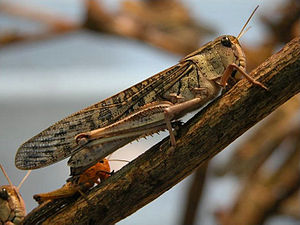- Migratory locust
-
Migratory locust 
Female migratory locust Scientific classification Kingdom: Animalia Phylum: Arthropoda Class: Insecta Order: Orthoptera Suborder: Caelifera Family: Acrididae Subfamily: Oedipodinae Genus: Locusta Binomial name Locusta migratoria
(Linnaeus, 1758)Synonyms - Acridium migratorium
- Acridium plorans
- Pachytylus australis Saussure, 1884
- Pachytylus migratorius (Linnaeus, 1758
- Pachytylus migratorioides (Fairmaire & L.J. Reiche, 1849)
The migratory locust (Locusta migratoria) is the most widespread locust species, and the only species in the genus Locusta. It occurs throughout Africa, Asia, Australia and New Zealand. It used to be common in Europe but has now become rare there. Because of the vast geographic area it occupies, which comprises many different ecological zones, numerous subspecies have been described. However, not all experts agree on the validity of some of these subspecies.
Many other species of Orthoptera with gregarious and migratory behavior are indicated with the name of 'locusts'.
Contents
Polyphenism
The migratory locust is polyphenic. It transitions between two main phenotypes in response to population density; the solitary phase and the gregarious phase. As the density of the population increases the locust transforms progressively from the solitary phase towards the gregarious phase with intermediate phases:
Solitaire = solitary phase → transiens congregans (intermediate form) → gregarious phase → transiens dissocians (intermediate form) → solitaire = solitary phase.
Pigmentation and size of the migratory locust vary according to its phase (gregarious or solitary form) and its age. Gregarious larvae have a yellow to orange covering with black spots. Solitary larvae are green or brown. The gregarious adult is brownish with yellow, the latter colour becoming more intense and extensive on maturation. The solitary adult is brown with varying extent of green colour depending on the colour of the vegetation. Gregarious adults vary in size between 40 and 60 mm according to the sex. They are smaller than the solitary adults.
Economic Impact
Locusts are highly mobile, and usually fly with the wind at a speed of about 15-20 km/h. Swarms can travel 5-130 km or more in a day. Locust swarms can vary from less than one square kilometre to several hundred square kilometres with 40 to 80 million individuals per square kilometre. An adult locust can consume its own weight (about 2 grams) in fresh food per day. For every million locusts, one ton of food is eaten.
In Africa, the last serious widespread plague of Locusta m. migratorioides occurred from 1928 to 1942. Since then, environmental transformations have made the development of swarms from the migratory locust unlikely. However, the desert locust which is very similar to the African migratory locust remains a major threat. Nevertheless potential outbreaks are constantly monitored as plagues can be devastating.
Locust survey and control are primarily the responsibility of the Ministry of Agriculture in locust-affected countries and are operations undertaken by national locust units. The Food and Agriculture Organization (FAO) of the United Nations provides information on the general locust situation to all interested countries and gives warnings and forecasts to those countries in danger of invasion.
List of 'locusts'
- American desert locust Schistocerca americana
- Australian plague locust Chortoicetes terminifera
- Bombay locust Nomadacris succincta
- Brown locust Locustana pardalina
- Desert locust Schistocerca gregaria
- Italian locust Calliptamus italicus
- Migratory locust Locusta migratoria
- Moroccan locust Dociostaurus maroccanus
- Red locust Nomadacris septemfasciata
- Rocky Mountain locust Melanoplus spretus – extinct
- Spur-throated locust, Australis procera - Australia
- Three locusts Anacridium spp.
- Anacridium aegyptium
- Anacridium melanorhodon
- Anacridium wernerellum
Borderline species
- Senegalese grasshopper Oedaleus senegalensis - often displays locust-like behaviour in the Sahel region
- Sudan plague locust Aiolopus simulatrix - occasionally behaves like a locust in eastern Sudan
Subspecies of Locusta migratoria
- Locusta migratoria var. burmana Ramme, 1951
- Locusta migratoria var. capito Saussure, 1884 (Madagascar)
- Locusta migratoria var. cinerascens Fabricius, 1781 (Italy, Spain)
- Locusta migratoria var. manilensis (Meyen, 1835) 1 (eastern Asia)
- Locusta migratoria var. migratoria (Linnaeus, 1758) (West and Central Asia, eastern Europe)
- Locusta migratoria var. migratorioides (Fairmaire & L.J. Reiche, 1849) (mainland Africa and Atlantic islands)
- Locusta migratoria var. tibetensis Chen, Yonglin, 1963
- Locusta migratoria var. danica (Linnaeus, 1767) - Locusta migratoria var. migratoria (Linnaeus, 1758)
- Locusta migratoria var. gallica Remaudičre, 1947 - Locusta migratoria var. migratoria (Linnaeus, 1758)
- Locusta migratoria var. solitaria Carthy, 1955 - Locusta migratoria var. migratoria (Linnaeus, 1758)
References
- Walker, Annette, The Reed Handbook of Common New Zealand Insects, Reed Books, 2000 ISBN 0-7900-0718-5
- Steedman, Alison (Ed.) 1988. Locust Handbook (2nd Edn). London: Overseas Development Natural Resources Institute, 180p. (ISBN 0-85954-232-7)
- Australian Plague Locust Commission (APLC)
- 2004 locust outbreak
External links
- Food and Agriculture Organization (FAO)
- The phenomenon of phases
- Biolib
- Fauna Europaea
- Genus Locusta at Orthoptera Species File on Line
- Www1.osu.cz
Gallery
Categories:- Locusts
- Orthoptera of Europe
- Insects of Asia
- Insects of Australia
- Insects of New Zealand
- Orthoptera of Africa
- Animals described in 1758
Wikimedia Foundation. 2010.


